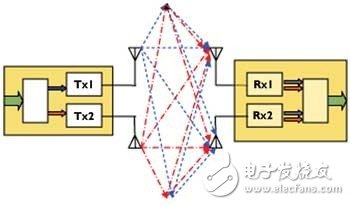In the early days of the advent of television, broadcast signals that also carried radio information were also received by the antennas of the television through a number of different wavelength paths, causing a lot of trouble for people. When signals are transmitted along these paths, the signals received by the TV antennas exhibit phase misalignment and mutual interference. As a result, TV shows that people see often appear as "ghosts" - some blurry images that interfere with the main picture of the TV. In today's digital age, this phenomenon has become a favorable thing, but it also brings greater system complexity. Flexible and clever selection of test tools ensures that this system complexity does not affect the functionality of the device. LitePoint's IQn & TImes;n test system combines hardware and software vector signal generation and analysis capabilities, greatly simplifying the design and production testing of MIMO-based devices. Currently, in the field of digital signal processing, designers typically separate broadband data, transmit it through multiple pairs of "transmitter-antenna" devices, and then capture, resolve, and reconstruct the original data stream. The goal of this technology is to achieve higher data throughput with the same amount of spectrum. Current MIMO (ie, multiple input multiple output) technology is closely related to the "second wave" technology wave of mobile WiMAX. MIMO is a relatively complex technology, so integrating it into a wireless system faces many challenges. The current MIMO specification supports a combination of "m&TImes;n" transmitter (m) and receiver (n), but m and n do not exceed 4 in existing real systems. In the black box way, WiMAX devices must input, separate, and transmit a certain amount of data streams, so that each transmitted signal satisfies the frequency, spectrum, and other technical specifications of MIMO. The receiver of the WiMAX device must capture the composite signal and parse it to produce a separate data stream, and then reconstruct the original data stream. WiMAX is similar to Wi-Fi in many ways. Although WiMAX supports higher data throughput and longer transmission distances than Wi-Fi, WiMAX, like Wi-Fi, will become a mass-market technology with equal cost and price. Therefore, despite the complexity of WiMAX technology, we must speed up research and development and minimize costs. Moreover, since users are often very sensitive to product quality and are not very concerned about the price of the equipment, manufacturing testing must maintain high product quality within a large market cost constraint. Most engineers associate MIMO with Wi-Fi because of the 802.11n standard. The 802.11n standard is based on the original Wi-Fi standards 802.11a, b and g, and defines a 2&TImes; 2, 20MHz channel MIMO implementation. This implementation uses two transmitters to transmit two separate data streams (space division multiplexing) resulting from the separation of one large data stream. These signals are transmitted to the two receivers over multiple paths, and the receiver reconstructs the original signal (as shown in Figure 1). Figure 1 For a 2&TImes;2 system, MIMO separates a wideband signal into two separate signal components. Essentially, separate data streams - each supporting Wi-Fi data rates in the 50 Mb/s range - produce a reconstructed data stream with a data rate of 70 Mb/s (theoretically, the rate can be up to 100 Mb/s). And, all of this data is integrated in a 20MHz channel. So MIMO increases data rates by 50% compared to traditional Wi-Fi with the same bandwidth. By using multiplexed mode, spatial differentiation techniques are employed on each receive antenna, enabling the DSP to separate signals and recover the original two streams of data. Independent transmitters using the same RF channel transmit independent data on their respective antennas, and then the receiving antennas combine the composite signals of all the transmitters. Independent data streams can be recovered through cleverly designed MIMO messages and advanced DSPs. There is an almost linear relationship between the data rate and the number of transmitters and antennas, and the increase in rate does not require an increase in channel bandwidth. In order to achieve efficient Wi-Fi MIMO functionality, designers must develop a system that produces high quality signals using a complex modulation technique called Orthogonal Frequency Division Multiplexing (OFDM). MIMO wireless architectures typically use zero intermediate frequency (ZIF) to achieve low cost, high efficiency OFDM through in-phase (I) and quadrature (Q) modulation. Among them, the baseband signal is separated into I and Q components. On the transmitter side, the system sends these components directly to the power amplifier and antenna, while on the receiver side, the system demodulates the RF signal to produce the baseband I and Q components. In an ideal world, this kind of solution is not wrong, but in fact many factors will cause trouble. Unbalanced amplitude, phase or group delay may occur between the I and Q signals, which affects the accuracy of the modulation. Inaccurate carrier frequencies, phase noise, local oscillator leakage, parasitic interference, and amplifier compression are all potential disadvantages, so designers are clearly facing significant challenges. The purpose of R&D testing is to find out these imbalances or unfavorable factors. These disadvantages may manifest themselves in various forms: differences in performance of baseband and RF chips, excessive component tolerances, transmission line impedance mismatch, parasitic capacitance and inductance differences associated with PCB layout, and amplifier nonlinearities. Although the designer can further address the source of these disadvantages by testing various aspects of the signal, it is a very time consuming and laborious task and can easily lead to errors and repeatability issues. Wireless Charger Car Phone Holder Wireless Charger Car Phone Holder,In Car Phone Holder Wireless Charger,Car Phone Holder And Charger,Phone Car Mount With Wireless Charger Ningbo Luke Automotive Supplies Ltd. , https://www.car-phone-holder.com
January 26, 2023